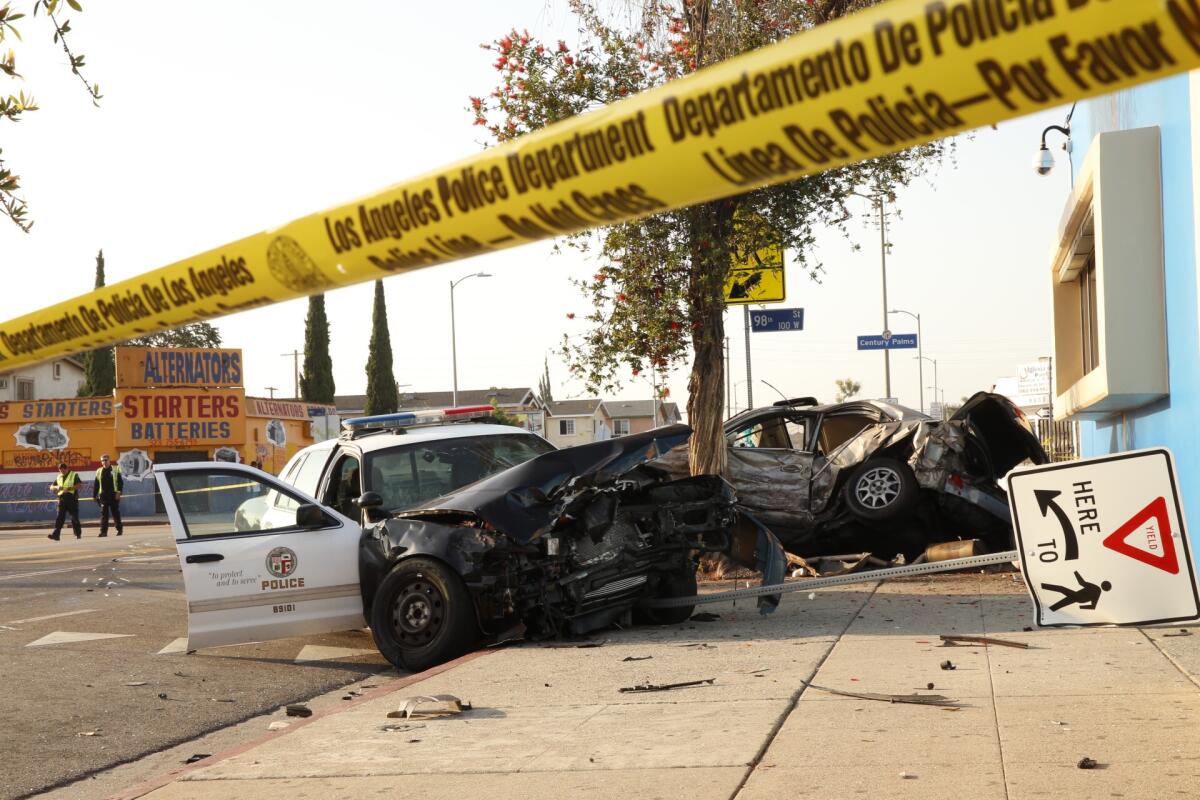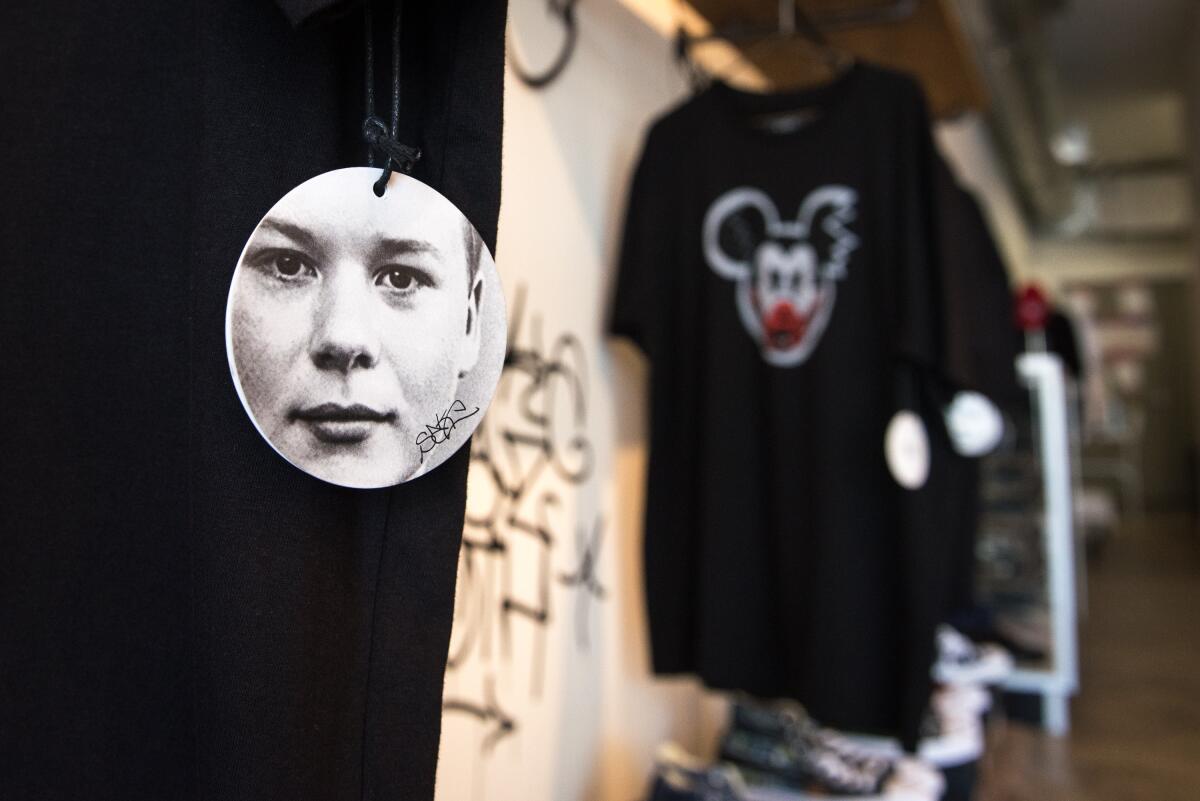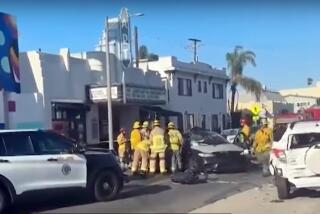Half of people injured in LAPD pursuits are bystanders, report says

- Share via
Almost half of the people injured or killed during police chases in Los Angeles since 2018 were bystanders, according to new LAPD data.
The findings, presented Tuesday to the Board of Police Commissioners, found that LAPD officers have been involved in at least 4,203 pursuits since 2018; roughly a quarter (1,032) resulted in a collision that caused injuries or death.
Nearly half of these injury crashes hurt people who weren’t involved in the chase — with 496 injured and nine killed. By comparison, 462 fleeing suspects were injured in that span, with five dying, according to the report.
Sixty officers were injured during chases; none have died.
Most collisions happened relatively early in a police chase, with more than three-fourths occurring within five minutes of the start of a pursuit, the report said. The average speed of pursuits was 46 mph; 64% of collisions occurred when chases reached speeds of 41 to 80 mph. Slightly over half of chases ended up covering a distance of less than two miles.
LAPD Deputy Chief Donald Graham said in an interview Tuesday that the debate over police chases is more nuanced than arguing for an across-the-board ban on pursuits for nonviolent crimes such as vehicle thefts. Many stolen vehicles are involved in hit-and-runs or are used to commit further crimes, he said.
Graham said the department has overhauled its training, supervision and policies to reduce the risk of crashes during high-speed pursuits. The increase in pursuit-related crashes coincides with a rise in vehicle thefts, he said.
“We’re telling our officers to be proactive and look for these situations [that are] going to cause an increase in the number of pursuits,” he said.
Under LAPD policy, officers are allowed to initiate a pursuit in response to a suspected felony or for certain misdemeanors such as reckless or drunk driving.
The LAPD has long struggled to limit the danger that its pursuits pose to civilians.
From 2006 to 2014, 334 bystanders were hurt as a result of crashes caused by LAPD chases. During that time, 1 in 10 pursuits resulted in the injury of someone who was not participating in the pursuit, according to a previous Times analysis of California Highway Patrol data.
In 2015 alone, at least 78 bystanders were hurt in LAPD chases, the highest tally in a decade, records show. Two years later, an L.A. County civil grand jury questioned whether the LAPD was properly training its officers and scrutinized the department’s practice of, at times, chasing suspects for nonviolent crimes.
Graham said that the LAPD didn’t modify its policy in direct response to the Times analyses or the grand jury report, but that “some of the things that we did in the review process have changed.” For instance, officers are now being judged not just on the pursuit’s outcome but also on their driving tactics. The actions of the passenger officer are also evaluated, he said.
The department’s policy on engaging in pursuits is considered permissive compared with those of other major American cities.
The Philadelphia, Phoenix and Dallas police departments have abandoned the practice of chasing people suspected of misdemeanors.

The pursuit intervention technique, also known as the PIT maneuver — which the LAPD sometimes uses to bump a fleeing vehicle when it is traveling below 35 mph in order to force it to stop — is banned by police in the country’s two other largest cities, New York and Chicago, records show.
The current debate comes against a backdrop of a broader conversation around the role of police traffic enforcement and rising traffic fatalities. A long-delayed study of alternative traffic approaches by the Los Angeles Department of Transportation, which could serve as a foundation for new legislation, is expected to be released in the coming weeks.
Recognizing that officers involved in a “high adrenaline situation” such as a pursuit may not be thinking straight, LAPD officers are now required to report their speeds to a supervisor, who can make a “dispassionate” decision of whether to terminate a chase, department officials said during a presentation Tuesday.
Of the 4,203 pursuits over the last five years, 406 ended up being called off by officers or supervisors. After internal investigations, 609 pursuits were found to be out of policy or resulted in an administrative disapproval against the officers involved. Both numbers rose in recent years, the report found.
After the department’s presentation, Police Commission President William Briggs said he was concerned by a number of recent chases that led to serious injury or the death to bystanders. He urged department officials to step up their training to ensure that the “average patrol officer on the street” understands and adheres to the LAPD’s chase policy.
“It raise the specter that pursing suspects may not be the best avenue under these circumstances, unless of course the suspect was wanted for ... bank robbery,” he said. “What else can the department do to help our officers engage in this type of critical analysis to mitigate or minimize the citizens getting injured?”
Graham responded that the department is training officers to constantly consider their surroundings and weigh factors such as the suspects’ speed and the weather in deciding whether to continue the pursuit.
“We know that this is the most dangerous thing that we do,” he said. “These are 3,000-pound bullets that are driving around our city at very high speeds.”
LAPD Cmdr. Craig Valenzuela told commissioners that 81% of the chases with the “most catastrophic outcomes” lasted under three minutes.
Valenzuela said LAPD officials have explored the use of various tools that would limit the need to initiate a chase, including one device that deploys a heavy-duty nylon rope designed to entangle the suspect vehicle’s axle to slow it down.
The department is also considering an adhesive GPS device, nicknamed “Star Chase,” that can be launched at a fleeing vehicle and enables officers to track its movements from a safe distance.
Commissioner Rasha Gerges Shields asked how rising auto theft rates might affect the number of police chases that end with a collision. Some jurisdictions, she pointed out, have banned such pursuits and are turning to technology such as drones to track suspects.
Graham said that he recently took a tour of the “current drone setup” of the Beverly Hills Police Department. The wealthy enclave has in recent years expanded its use of drones, cameras and other surveillance tools to combat crime.
But the blanket surveillance has been met with concern from some privacy rights advocates, who see it as a move toward greater government intrusion into people’s lives.
More to Read
Sign up for Essential California
The most important California stories and recommendations in your inbox every morning.
You may occasionally receive promotional content from the Los Angeles Times.












